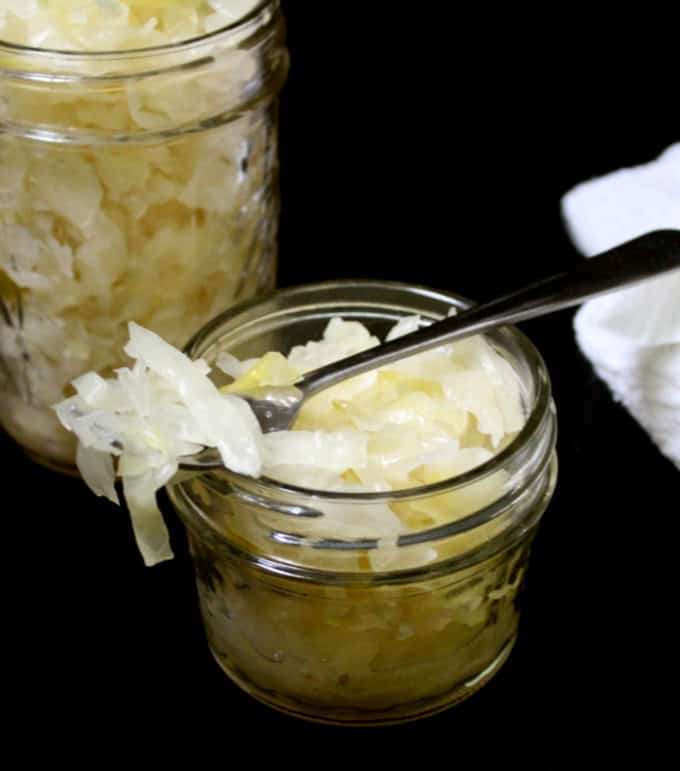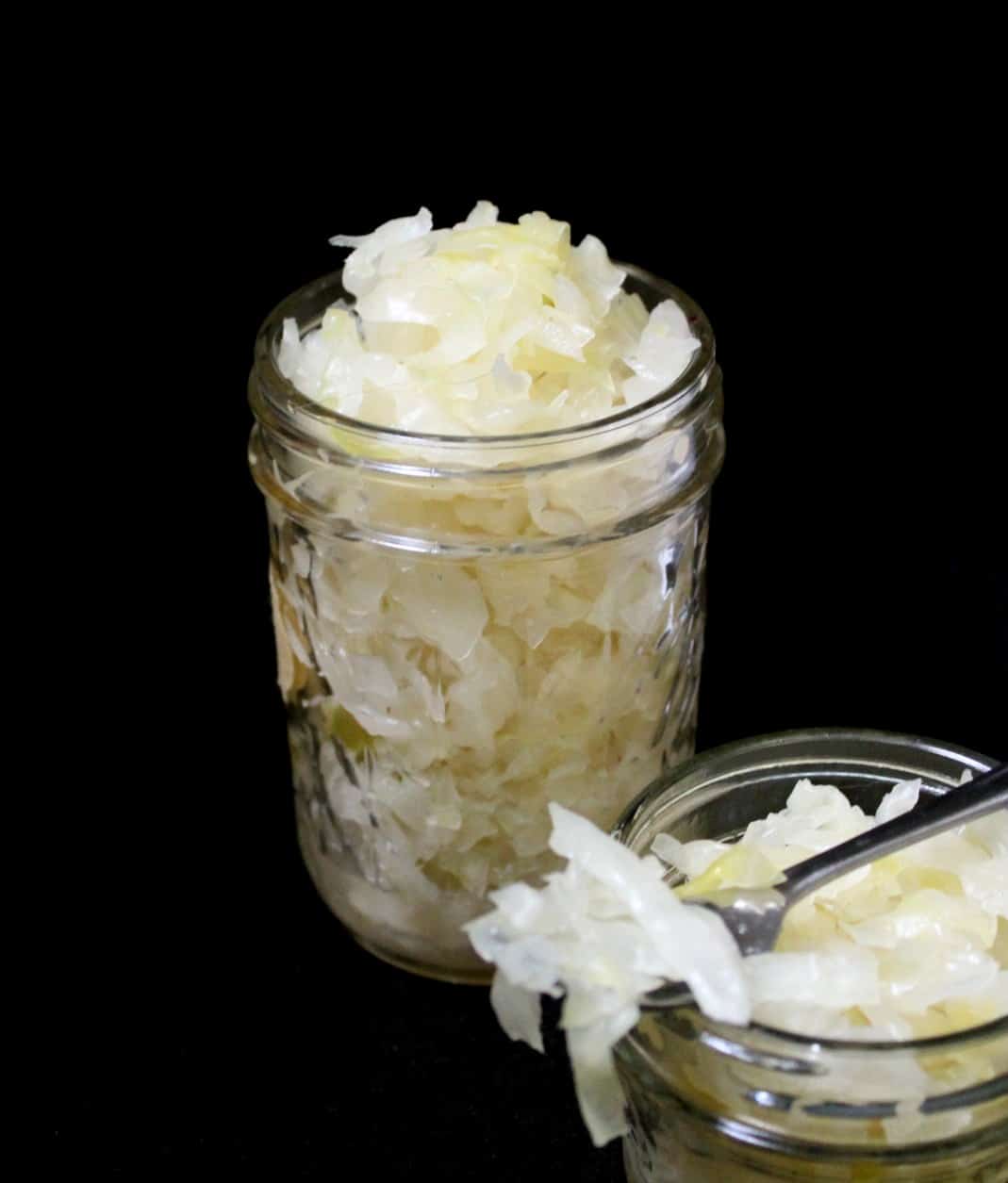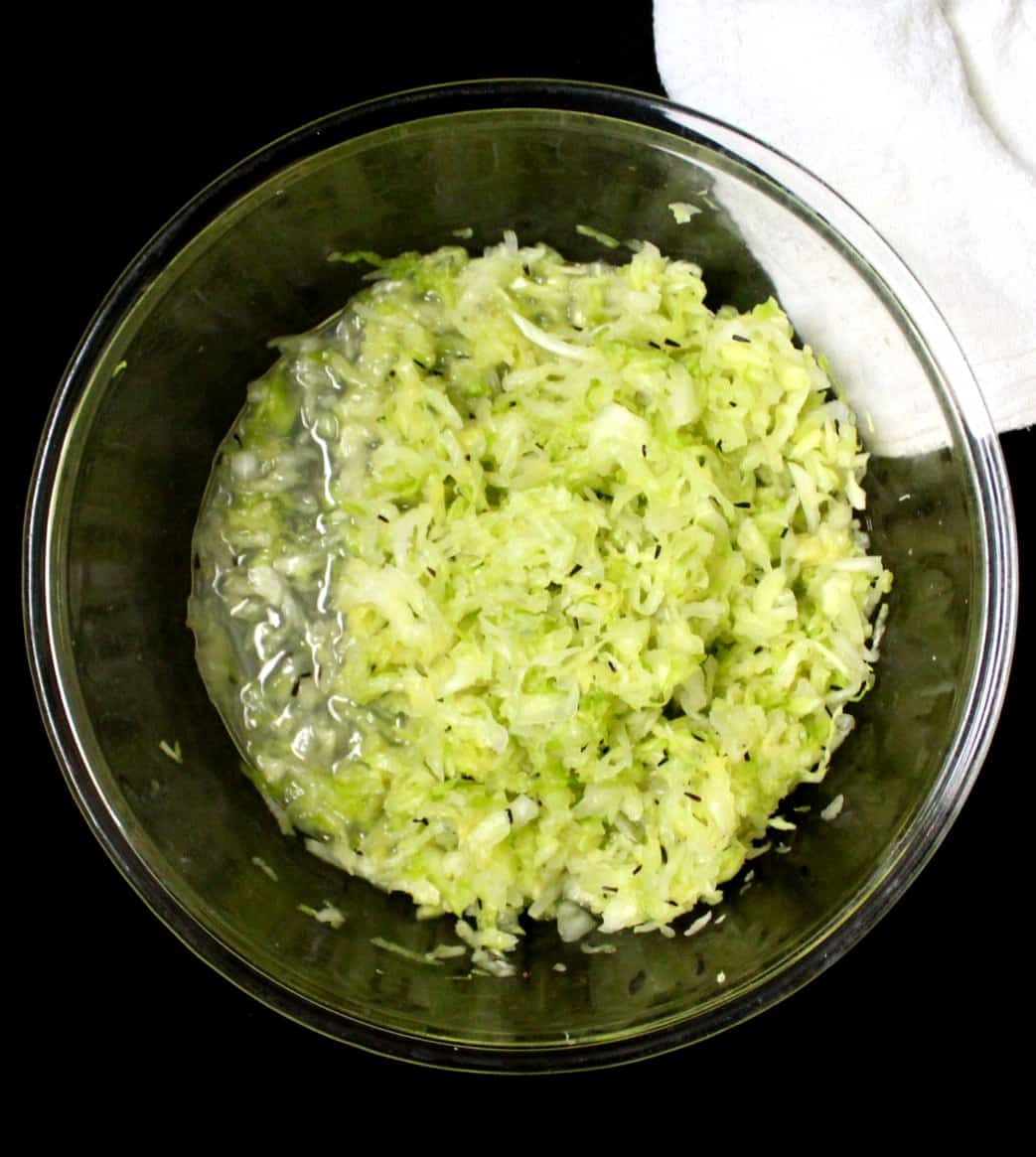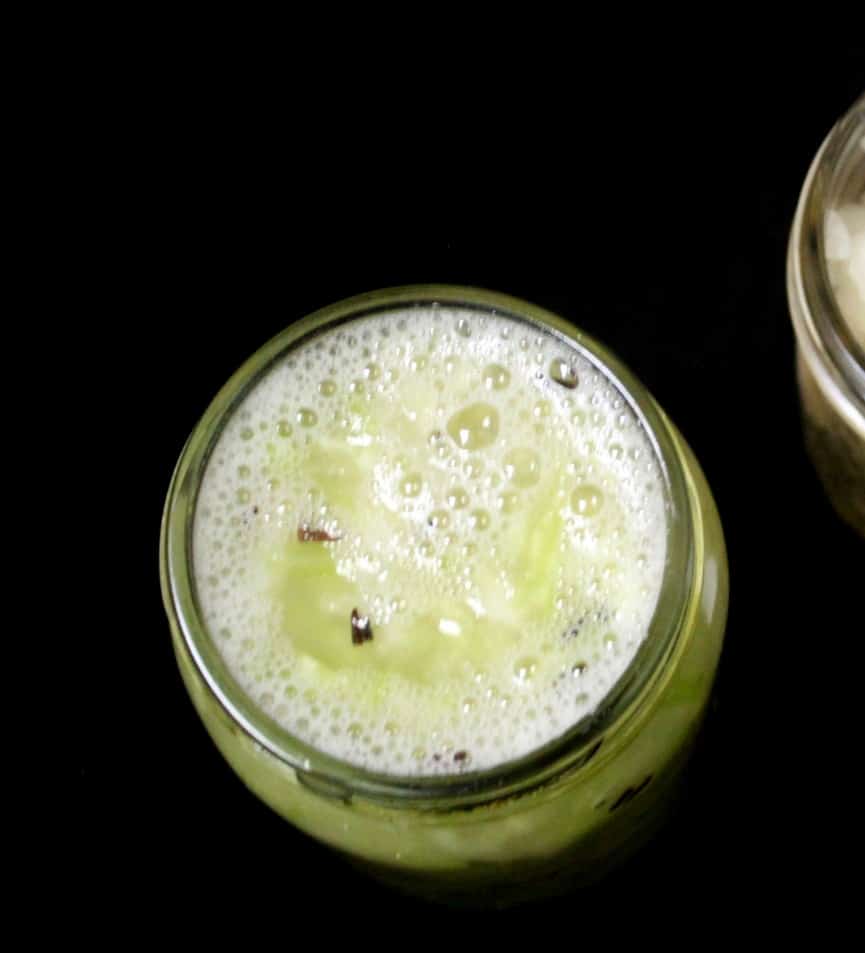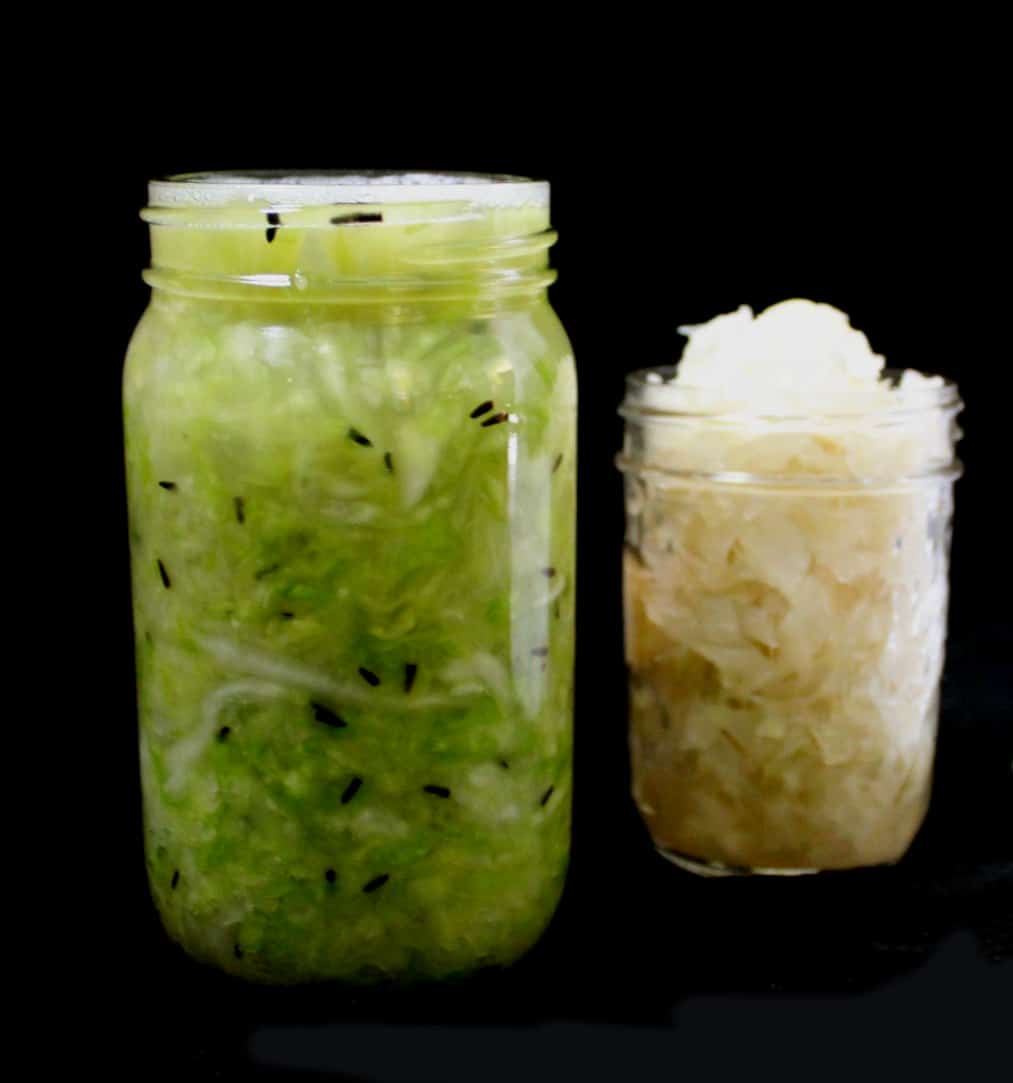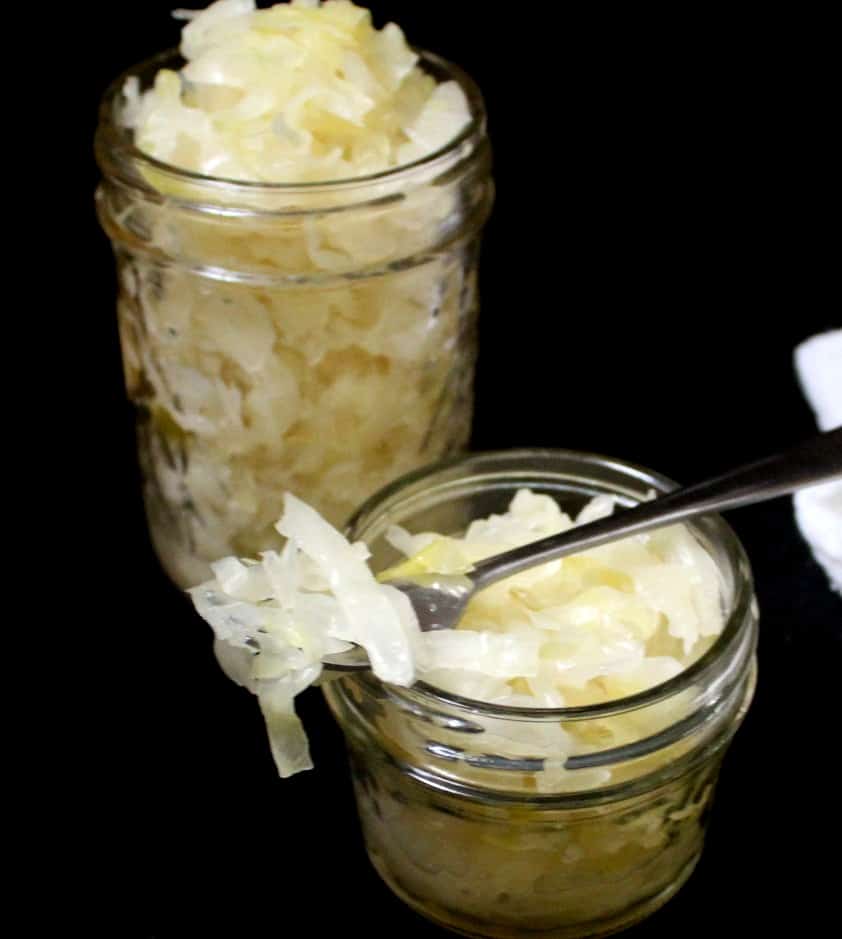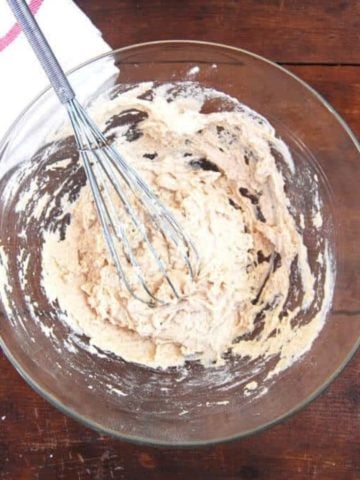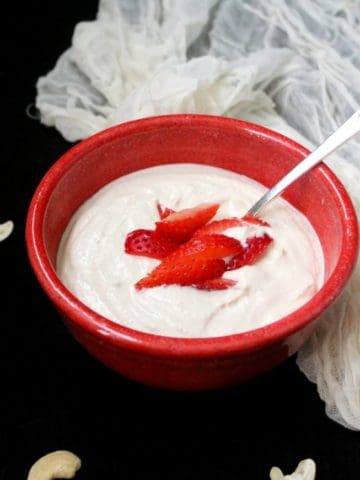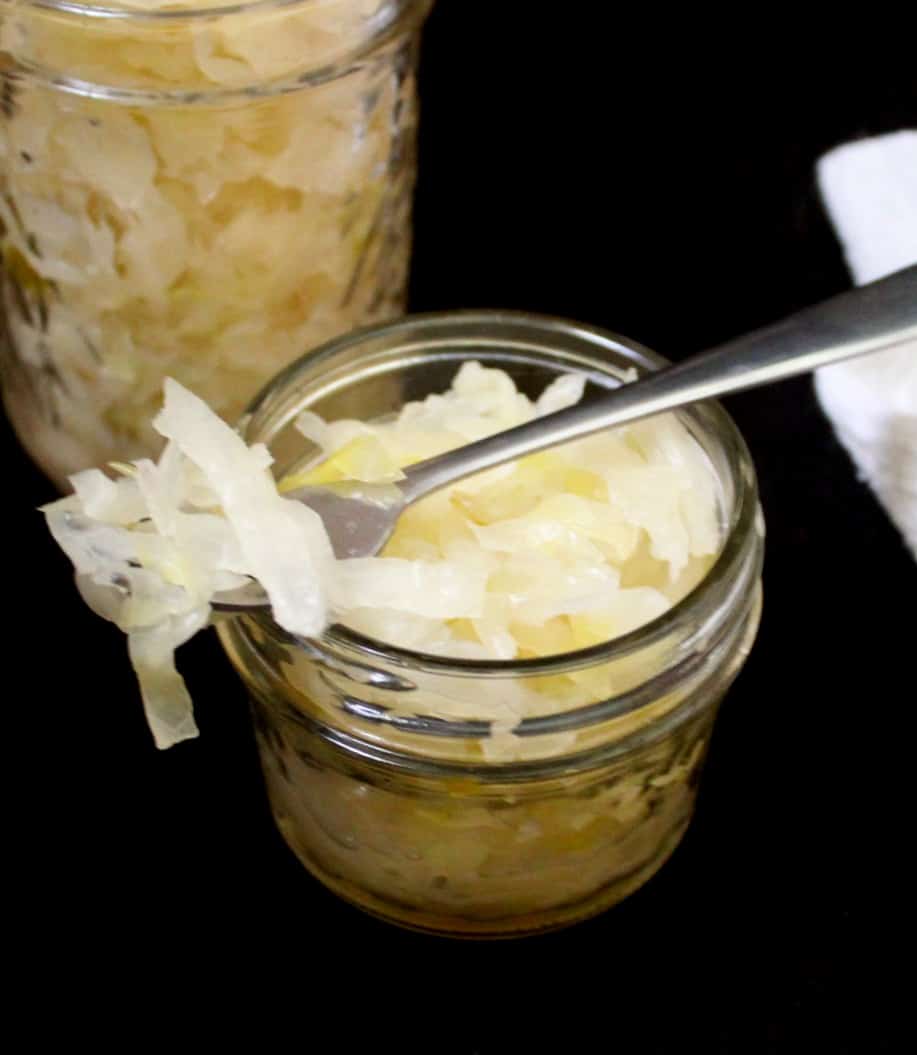I’m sharing with you today my recipe for homemade sauerkraut, a condiment that’s almost always in my refrigerator because of its amazing taste and immense health benefits. I started making my own sauerkraut years ago, and I stuck with it because it’s just so much fun to do. For one, it’s the easiest thing anyone can make. All you need to do is shred cabbage, add salt, and then knead and massage the cabbage until it lets go of the juices inside it. It’s immensely therapeutic work and once you’ve got the hang of it, you’ll be looking forward to it. As your sauerkraut ferments, you will love checking on it and seeing it bubble up with life. 🙂 And after it is ready, there is so much you can do with it, besides using it as a topping for your veggie burgers and sandwiches, or stirring it into a salad. You can add it to dishes like mashed potatoes to make them healthier, and even some cooked foods (studies show that the benefits of probiotic foods are not altogether lost during cooking). If you have a salty tooth, like I do, you could even just eat it by itself. I’ve been meaning to post this sauerkraut recipe for a while, and some of you have asked for it, but I wanted to wait until I could begin a new batch so I could show you, step by step, how I make it. There’s not much of a recipe here, so this is going to be more of a tutorial. I’m going to attempt to answer common questions that could come up as you make your sauerkraut, and help guide you through some of the most common pitfalls. While making sauerkraut is easy, you do have to exercise some care to make sure the cabbage does not get moldy. But that’s easy enough to avoid so long as you follow instructions and understand what you need to do to make sure the cabbage is not exposed to the elements during the fermentation process. To be clear, you are not going to see daily changes in the sauerkraut the way you would with a sourdough starter (and I hope you already have one of those). But you will see the cabbage soften and change color and you’ll see some bubbling as the good bacteria go to work on the cabbage. I used green cabbage for my sauerkraut this time, but you can use purple cabbage as well. And although the sauerkraut is delicious by itself, you can add in some flavors to it, like caraway seeds, ginger and dill.
The science behind sauerkraut
Sauerkraut is created by a lactic acid fermentation process. Once you’ve shredded the fresh cabbage and packed it into a glass jar with its own juices and the brine, you leave it alone to “pickle” for a week or so. The cabbage ferments over time, thanks to air-borne lactobacilli and other bacteria, which live on the cabbage leaves. The bacteria that populate the sauerkraut are the friendly kind, with lots of benefits for humans–benefits you get when you consume sauerkraut. You can use the basic pickling process used to make sauerkraut to make other fermented vegetables as well, including carrots and beets.
Why you’ll love this sauerkraut recipe
Easy recipe. Making homemade sauerkraut is easy and simple with just a few basic instructions and tools. So healthy. Sauerkraut is an amazing condiment. It is low in calories and utterly healthy. Sauerkraut contains friendly gut bacteria that will do your digestive system a world of good. It’s also packed with healthy Vitamin C that will help keep your immune system working smoothly. And it’s a great aid for weight loss. Delicious. It is just fermented cabbage but sauerkraut is one of my most favorite condiments because it goes with just about everything. It is perfect to pile onto burgers or cook into this Vegan Colcannon with Sauerkraut or Vegan Potato Sauerkraut Pancakes. Everyone friendly. There are no nuts, soy of gluten in sauerkraut and it’s just cabbage and salt so it’s vegan, of course.
Top tips
Choose a good looking, preferably organic cabbage: It’s best to use organic produce for pickling, and make sure the cabbage you use is fresh. Remove any wilting leaves or anything that’s turning brown. You don’t want that in your sauerkraut. Both green and purple cabbages are fine here. Shred the cabbage finely: And by that I do not mean throw it in the food processor. I am not above taking the help of a processor to shred veggies more often than not, but you really want to hand-cut the cabbage here because you want thin, even, longish shreds. I do this by halving the cabbage, coring it, then cutting it into quarters. Start shredding the cabbage as finely as possible. If you want shorter strands, cut them into halves or thirds, it really doesn’t matter. Use the right kind of salt: This means you should not be using table salt or iodized salt, the kind commonly found in supermarkets. In addition to being devoid of any natural chemicals, like the ones you’d find in Himalayan pink salt, table salt and iodized salt have chemical additives that will inhibit the bacteria in the sauerkraut. Use the pink salt if you have it, or use kosher salt at a pinch. Take time to massage the cabbage: You need about 10 minutes of hands-on time and by that time the cabbage should have expressed enough juices to provide all the brine you need. I usually salt the cabbage, rub it in, crushing the cabbage shreds at the same time, for about two minutes. Then I leave the cabbage alone for 15 minutes or so and come back and continue massaging it. The break gives the salt enough time to soften the cabbage and release more juices, making my work a little easier. Although, like I said, it’s a fun and therapeutic job you will really enjoy. Use a glass jar: Don’t use plastic jars for anything that will be fermenting, it’s just not a good idea. A glass mason jar with a two-piece lid is ideal because it allows the sauerkraut to vent. But if you don’t have that, any recycled glass jar with a lid will work. In that case don’t screw the lid on too tight, or just cover the mouth of the jar with cheesecloth while the sauerkraut is fermenting. You can replace the cheesecloth with a lid once the sauerkraut is ready to be refrigerated. Pack the cabbage tight into the jar: This is important because you want to minimize any air in the jar and also make sure that the cabbage remains submerged in brine. I do this by adding a couple of spoonfuls of cabbage to the jar, pressing down on it with the back of a heavy spoon, then two more spoonfuls, and so on. You’ll be surprised at how much sauerkraut you get into a single jar this way. Make sure the cabbage is covered in brine: I am going to repeat this because it’s the most important thing you can do to ensure the success of the sauerkraut recipe: ALWAYS KEEP THE SAUERKRAUT SUBMERGED IN BRINE. Cabbage is a veggie and exposed to the air at room temperature it will develop mold. If you don’t, for any reason, get enough juice from the cabbage itself, I’ll include instructions for a brine solution you can make and add to the jar. To ensure that the cabbage remains submerged, use one of the big outer leaves of the cabbage. Fold the leaf to roughly fit into the mouth of the jar and place it on top of the cabbage shreds. The leaf should also be submerged in brine at all times. Leave at least an inch of space at the top of your jar to give the juices room to expand and vent. Don’t screw the lid on tight: Again, to give the juices room to come out, if they want to. I place the jar in a shelf with kitchen towels underneath in case there is any overflow. You can also place it in a bowl or dish. Place the mason jar in a cool, dark place and let it do its thing: There’s no daily feeding here, like you have with sourdough. Just let the sauerkraut stand and let the probiotic bacteria on the surface of the cabbage go to work, fermenting it and turning it into something delicious. I like to vent the sauerkraut every couple of days. I take the jar out, open the lid, and let any juices overflow if they want to. This also gives me an opportunity to make sure everything is still submerged in brine. If you need to top off with more brine, although this should not be necessary. Refrigerate the sauerkraut: After seven days, your sauerkraut should be ready. You can eat it at this point and store the rest in the refrigerator where it will continue to slowly ferment, getting even tastier. Sauerkraut can last in a refrigerator for at least a couple of months or even longer.
Troubleshooting
As easy as making sauerkraut is, remember you are dealing with bacteria and veggies, and that combination, if not handled properly, can easily go the wrong way. But you shouldn’t get to that point if you follow a few basic tips: Check to get new recipe updates by email.
Shred the cabbage finely and evenly. Pack it very tightly into the mason jar. Keep the cabbage submerged in brine at all times. All of the cabbage should be covered with brine, and not a single shred of it should be exposed to the air, which would encourage mold. If your jar isn’t completely filled, make sure you don’t have tiny bits of cabbage stuck to the sides and not covered by brine. Remove any that may be before you set the jar aside for fermentation. When I say “brine” here, I mean the salty juices expressed from the cabbage. You should have enough juice from the cabbage itself to cover the shreds completely, but if you don’t you will need to make a separate brine solution and top the sauerkraut with it. Don’t fill the mason jar all the way to the top. You want to give at least a half inch of space at the top because as the cabbage ferments and the bacteria bubble, the liquid will expand. To that end, also don’t screw the lid of your mason jar on very tight when the sauerkraut is fermenting, in case the liquid needs to vent. I screw on the lid loosely, then keep the jar in a dark shelf in my kitchen with a paper towel under it to catch any overflow. You can also cover the jar with cheesecloth instead of a lid. Every couple of days I’ll open the jar and give the liquid a chance to vent if it wants to. If, at any point, the cabbage looks moldy, the brine gets clouded, or anything smells off, do not try to sneak a taste. Just throw it away.
More gut-friendly vegan recipes
Recipe card
